Why should we care about Zika? News of the Zika virus is all around, but how dangerous is it really? And is Zika relevant for people who are not intending to have kids? Here’s my four-part journey on what we actually know and don’t know about the Zika virus to date.
Part 1: What is Zika and why is it in the news?
Part 2: What diseases does Zika cause? How do I know if I have Zika?
Part 3: How do I avoid getting Zika?
Part 4: What’s the future of the Zika virus?
Part 1: What is Zika and why is it in the news?
Zika is not a new virus. Like all zoonotic viruses (meaning of non-human origin that’s jumped over to humans) it has been around for a long time. So why are we only hearing about it now? Perhaps because we didn’t think it was a virus that causes serious damage and the number of people affected by it was limited. In fact, there are many small virus outbreaks that no one ever hears about simply because of their magnitude. If you want to get hysterical about possible looming epidemics, check out the website of the European Centre for Disease Prevention and Control (ECDC).
Zika is a flavivirus, which means it belongs to the same group as dengue, yellow fever, Japanese encephalitis, and the West Nile virus.
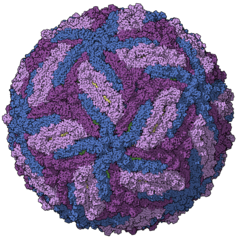
The virus was first isolated from a sick monkey in the Zika Forest in Uganda in 1947, hence its name. It was then found in mosquitoes in that same forest a few years later. In 1968, Zika was first isolated from humans in Nigeria. It was known that the virus caused mostly transient febrile illness, in combinations with a possible rash, headache, joint pain, and conjunctivitis. Most patients recovered fully within a week and so the disease associated with the Zika virus was perceived as mild and self-limiting.
In 2007, however, there was an outbreak on Yap Island in the southwestern Pacific Ocean. This was the first time the virus was detected outside of Africa and Asia, and it had infected nearly 75% of the population.1 In 2013 Zika’s spread continued to French Polynesia, and it was estimated that around 32,000 people were infected. This time a few cases of Guillain-Barré syndrome (GBS) were linked to the virus. GBS is a disorder in which the body’s immune system attacks its own nerve cells, which can lead to paralysis.2 There is only an association between Zika and GBS – the literature on the causality between Zika and GBS is unsatisfactory.3 What we do know is that neurological problems, not necessarily GBS, can arise following Zika infections.
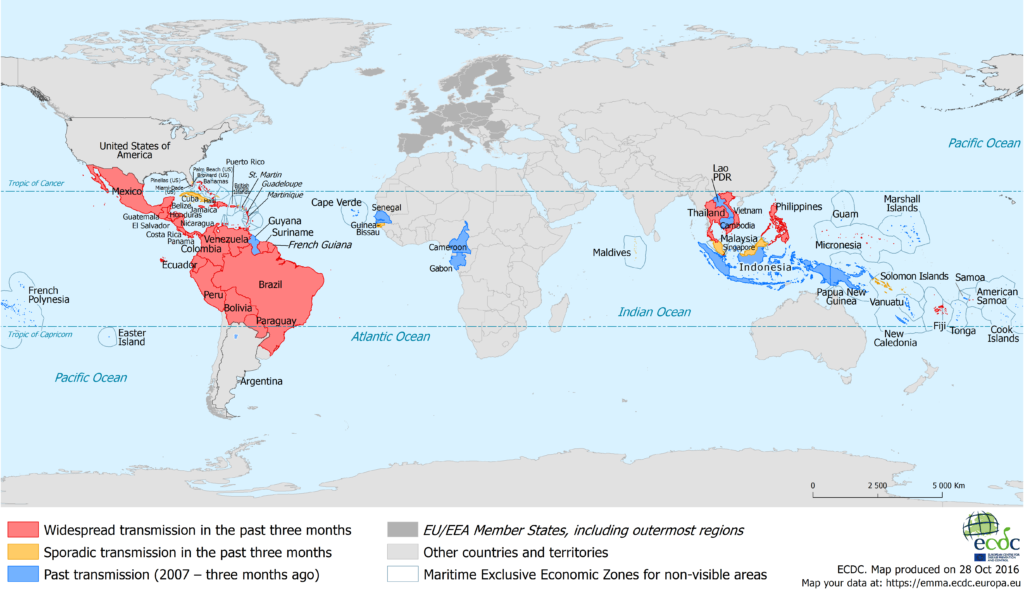
After French Polynesia, more and more Pacific islands were affected by outbreaks in 2014 and 2015, but the reason you and I know about Zika is because Brazil was hit hard in 2015, and the Olympics were planned for 2016. Within a few months Brazil had 1.3 million suspected cases. By September 2015 there was an unusual increase in the number of infants born with microcephaly in the same area Zika had first been reported.4 And so the rest of the world took notice.
Part 2: What diseases does Zika cause? And how do I know if I have Zika?
In 80% of cases, after being infected by the Zika virus, you won’t notice anything. If you do, you’re most likely to come down with a mild flu. Only in very rare cases does it cause neurological problems. I asked myself just how rare, but could not find any solid information on how many patients actually get neurological problems following a Zika infection. Zika can cause severe problems for an unborn child of a Zika-infected mother called the congenital Zika syndrome, which includes microcephaly.
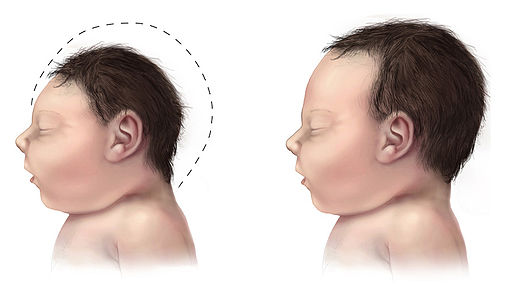
Microcephaly basically means a baby’s head is much smaller than expected, usually leading to developmental delays, intellectual disability, and a range of other problems from mild to severe. Microcephaly is another possible outcome from infection with toxoplasmosis,5 rubella or cytomegalovirus during pregnancy, so it’s not exclusively linked to the Zika virus.6 A preliminary study with 42 patients showed that 29% of the Zika infected mothers showed fetal abnormalities. Of the 12 infected mothers, two had miscarriages. It also didn’t matter when during pregnancy the women were infected.7
The more I dug into the association between Zika and birth defects, the foggier the information became. It is important to remember that most pregnant Zika infected women are having babies without any abnormalities. We really don’t know yet why there is this sudden increase in cases of microcephaly in the South American population, and why this was not seen in previous years. Some hypothesize that there may be differences in Zika’s ability to cause disease.8 Zika’s ability to mutate/change very quickly is due to it being an RNA virus rather than a DNA virus.9 Others argue that the effects of Zika seem worse at the moment because a larger population is affected and the Americas provide an ideal mosquito-breeding climate.
A brand new study published in Nature on the 31st of October showed that mice testes are severely damaged by Zika. These results highlight the uncertainty surrounding Zika and the need to investigate Zika’s effects on the function and viability of sperm in humans.10
How do I know if I have Zika?
Get tested. The CDC recommends that asymptomatic women who live in areas with active Zika transmission should be tested for Zika IgM as part of the routine obstetric care during the 1st and 2nd trimesters. This test tells you if the person’s immune system has created an antibody response to a flavivirus, not necessarily Zika. If the test is positive, you could have had dengue or another flavivirus.11 Therefore, a positive IgM test should be followed by a real time RT-PCR test,12 which gives a definitive diagnosis of Zika infection. The testing is equivalent for men.
Part 3: How do I avoid getting Zika?
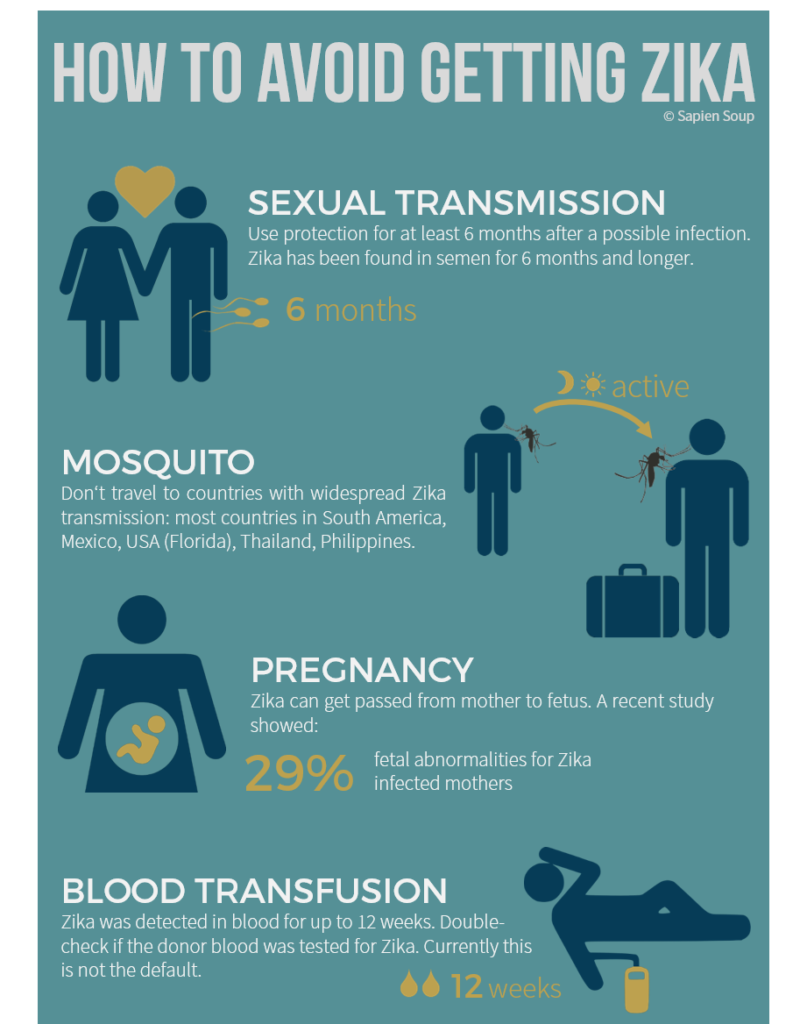
Mosquito
The number one way to get infected with the Zika virus is by being bitten by a mosquito. Mostly the culprit is the Aedes mosquito species (specifically A. aegypti and A. albopictus), which typically bite during the daytime and are widely spread throughout the tropical and subtropical regions as well as most of southern Europe.4
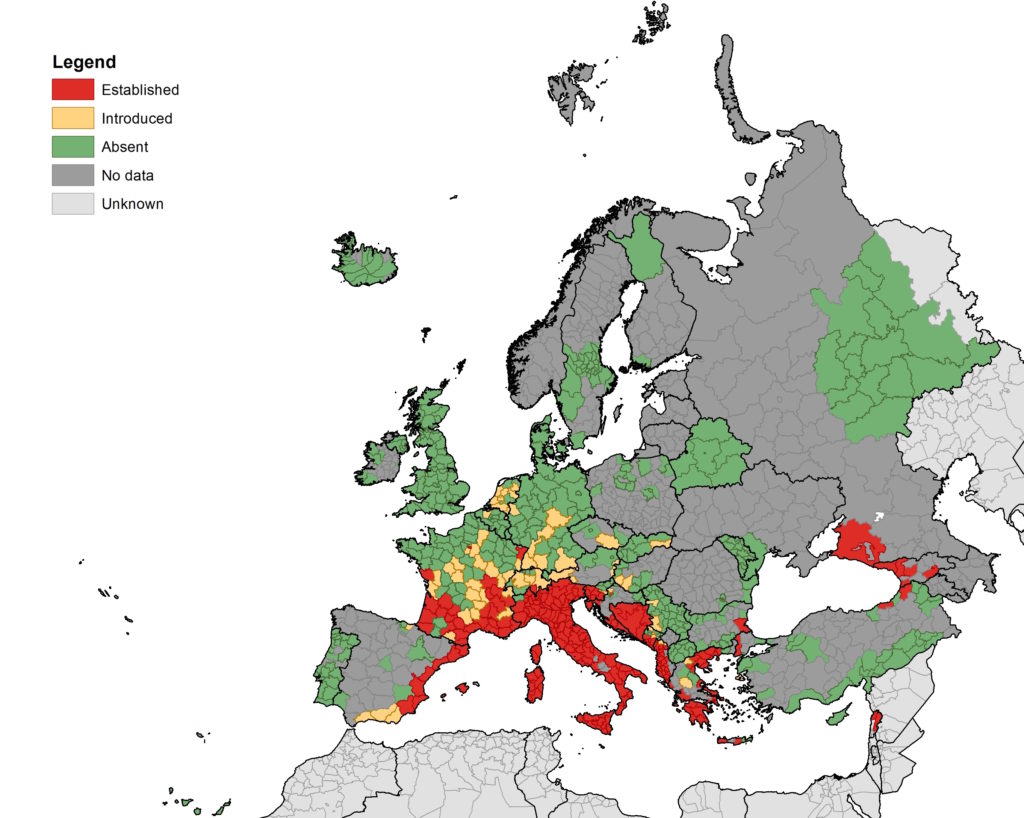
Sexually transmitted
Researchers have been able to detect virus particles in the blood, urine and semen (as well as saliva and tears) of infected patients, and over 30 cases of sexual transmission have been documented.
When I looked into this more closely, I found lots of conflicting information on how long Zika remains in the blood, and if all the bodily fluids, in which virus particles have been detected, can actually be infectious. Unfortunately, most studies have only been able to follow patients for a short period of time, because Zika has only been in the spotlight over the past year. Zika was detected in the blood of a patient for up to 81 days after the onset of symptoms.13 This was the longest recorded case of Zika found in blood.
The WHO has recommended asymptomatic men and women returning from Zika endemic areas, to wait 6 months before having unprotected sex.14 The Zika virus seems to reside longest in semen with studies showing it was detected in one patient for up to 188 days, 181 days in another and 92 days in a third patient. In the first two case studies the final samples taken contained Zika, whereas in the third study no virus was detected in subsequent samples. Therefore, I believe that it may be wise to wait longer than 6 months. If you are family planning and have returned from a Zika-endemic country, it’s a good idea to get tested, because you could still be carrying the virus.
from mother to fetus
Virus particles were detected in the amniotic fluid, fetal brain, and in the blood of babies, as well as in the breast milk of infected mothers.
via blood transfusion
In August 2016 the FDA put forward the recommendation that all blood donations should be tested for the Zika virus, but this is an expensive recommendation.
Testing for Zika (with real time RT-PCR) can cost up to $500 per test in the USA, while a clinic in London offers this test for £383. In Austria you can get tested at the “Referenzzentrale für Arboviren an der Virologie der Medizinischen Universität Wien”.
Checklist for family-planners
- Avoid traveling to areas with wide spread transmission. At the moment most of South America, Mexico, USA – in particular Florida, Thailand and the Philippines, for weekly updates check the website of the ECDC
- Don’t have unprotected sex with someone recently back from one of these areas, or make sure that person has tested negative for Zika
- Plan your next summer holidays away from the areas likely to get Zika next summer, this includes most of southern Europe – the mountains are a great alternative
Part 4: What’s the future of the Zika virus?
Research on Zika has taken off and fortunately funding has increased to meet the demands set by this new epidemic. This can be seen by the number of publications found on PubMed: since the first paper in 1952 there were a total of 208 publications until 2016. A stunning 88% of all Zika papers on PubMed15 were published in the last 11 months!
Researchers are trying to understand the virus, how it spreads, and the resulting disease in order to develop possible therapies and vaccines. Currently, there are 4 clinical trials focused on Zika vaccines registered on clinicaltrial.gov. However, the fear is that vaccinating a large population may not be cost-effective, as there are only sporadic outbreaks. This means the cost of disease treatment may be lower than the cost of a Zika vaccine. Another worry is that a vaccine will simply not be affordable to the parts of the world that need it most.16 The research community is facing questions such as which population to vaccinate and when, as well as classic vaccination problems, like how many doses are necessary to achieve protection and just how long this protective effect will last.17
Is there a way to treat Zika?
No approved anti-virals for Zika exist yet. To discover new treatments for the Zika virus, scientists have thrown together FDA-approved drugs or compounds, human cells, and the Zika virus in a Petri dish to see which drugs reduce or stop the infection. This method has generated a few possible anti-viral candidates, but these need to undergo much more testing before they can even be considered in preliminary human trials.18 19
What’s the situation in Austria?
One of the main reasons I began investigating this topic is to know what my risks are of catching Zika right here in Austria. It turns out, Zika has even made it to Austria. We have had 29 diagnosed Zika cases in 2016,20 but these were all imported from other countries. So far it seems we are safe from Zika, but this could change with warmer summers and new mosquito populations.
What can we expect in the future?
The bad news: Zika will continue to spread. The mosquito A. albopictus is already present in many parts of southern Europe (e.g. Italy, parts of France & Spain), the chances are relatively high that one of these bites an infected individual and begins spreading the virus. In Europe most pregnant women are screened at the start of pregnancy to determine their immune status on a few dangerous infections during pregnancy. I can only assume Zika will eventually be added to the list.
The good news: Zika appears to be mostly a harmless virus, with only 20% of all infected individuals actually getting any symptoms at all. So my suggestion: don’t panic.
-
Hayes EB. Zika virus outside Africa. Emerg Infect Dis. 2009 Sep;15(9):1347-50. doi: 10.3201/eid1509.090442. Review. PubMed PMID: 19788800. ↩
-
Leis AA, Stokic DS. Zika Virus and Guillain-Barre Syndrome: Is There Sufficient Evidence for Causality? Front Neurol. 2016 Sep 30;7:170. PubMed PMID: 27746763. ↩
-
Petersen LR, Jamieson DJ, Powers AM, Honein MA. Zika Virus. N Engl J Med. 2016 Apr 21;374(16):1552-63. doi: 10.1056/NEJMra1602113. Review. PubMed PMID: 27028561. ↩ ↩2
-
In Austria from 1992 to 2008, 13% of women infected with toxoplasmosis during pregnancy transmitted the infection to the fetus. (Prusa AR, Kasper DC, Pollak A et al. The Austrian Toxoplasmosis Register, 1992-2008. Clin Infect Dis. 2015 Jan 15;60(2):e4-e10. doi: 10.1093/cid/ciu724. PubMed PMID: 25216688.) ↩
-
The CDC’s information on microcephaly ↩
-
Brasil P, Pereira JP Jr, Raja Gabaglia C et al. Zika Virus Infection in Pregnant Women in Rio de Janeiro – Preliminary Report. N Engl J Med. 2016 Mar 4. PubMed PMID: 26943629. ↩
-
Wikan N, Smith DR. Zika virus: history of a newly emerging arbovirus. Lancet Infect Dis. 2016 Jul;16(7):e119-26. doi: 10.1016/S1473-3099(16)30010-X. Epub 2016 Jun 6. Review. PubMed PMID: 27282424. ↩
-
Grubaugh ND, Andersen KG. Navigating the Zika panic. F1000Res. 2016 Aug 4;5:1914. PubMed PMID: 27746903. ↩
-
Govero J, Esakky P, Scheaffer SM et al. Zika virus infection damages the testes in mice. Nature. 2016 Oct 31. doi:10.1038/nature20556. PubMed PMID: 27798603. ↩
-
Duffy MR, Chen TH, Hancock WT et al. Zika virus outbreak on Yap Island, Federated States of Micronesia. N Engl J Med. 2009 Jun 11;360(24):2536-43. doi: 10.1056/NEJMoa0805715. PubMed PMID: 19516034. ↩
-
Real time RT-PCR is a way to detect and quantify RNA levels ↩
-
Murray KO, Gorchakov R, Carlson AR et al. Prolonged Detection of Zika Virus in Vaginal Secretions and Whole Blood. Emerg Infect Dis. 2017 Jan 15;23(1). doi: 10.3201/eid2301.161394. PubMed PMID: 27748649. ↩
-
The WHO’s Fact Sheet on the Zika virus ↩
-
Checked on 29.10.2016 on PubMed ↩
-
Dittmer DP. Zika vaccine: Clinical trial and error? Science. 2016 Sep 23;353(6306):1375. PubMed PMID: 27708030. ↩
-
Abushouk AI, Negida A, Ahmed H. An updated review of Zika virus. J Clin Virol. 2016 Oct 3;84:53-58. doi: 10.1016/j.jcv.2016.09.012. Review. PubMed PMID:27721110. ↩
-
Barrows NJ, Campos RK, Powell ST et al. A Screen of FDA-Approved Drugs for Inhibitors of Zika Virus Infection. Cell Host Microbe. 2016 Aug 10;20(2):259-70. doi: 10.1016/j.chom.2016.07.004. Epub 2016 Jul 28. PubMed PMID: 27476412. ↩
-
Xu M, Lee EM, Wen Z et al. Identification of small-molecule inhibitors of Zika virus infection and induced neural cell death via a drug repurposing screen. Nat Med. 2016 Oct;22(10):1101-1107. doi: 10.1038/nm.4184. PubMed PMID: 27571349. ↩
-
According to Dr. Aberle from the Medical University of Vienna (27 from Vienna, 2 from Innsbruck) on the 25th of October 2016 ↩
